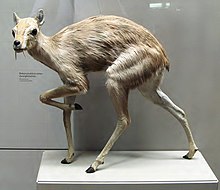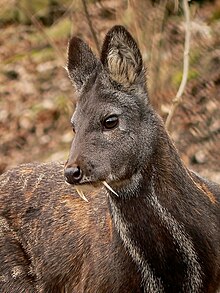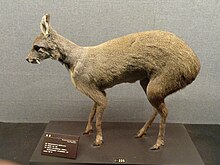Musk deer

Multi tool use
| Musk deer Temporal range: Early Oligocene–recent PreЄ Є O S D C P T J K Pg N | |
|---|---|
 | |
Siberian musk deer | |
Scientific classification | |
| Kingdom: | Animalia |
| Phylum: | Chordata |
| Class: | Mammalia |
| Order: | Artiodactyla |
| Family: | Moschidae Gray, 1821 |
| Genus: | Moschus Linnaeus, 1758 |
| Species | |
| |
Musk deer (Sanskrit:कस्तूरी मृग, and Hindi: कस्तूरी हिरन ) can refer to any one, or all seven, of the species that make up Moschus, the only extant genus of the family Moschidae.[1] The musk deer family differs from cervids, or true deer, by lacking antlers and facial glands and by possessing only a single pair of teats, a gallbladder, a caudal gland, a pair of tusk-like teeth and—of particular economic importance to humans—a musk gland.
Musk deer live mainly in forested and alpine scrub habitats in the mountains of southern Asia, notably the Himalayas. Moschids, the proper term when referring to this type of deer rather than one/multiple species of musk deer, are entirely Asian in their present distribution, being extinct in Europe where the earliest musk deer are known to have existed from Oligocene deposits.
Contents
1 Characteristics
2 Evolution
2.1 Taxonomy
3 References
4 External links
Characteristics

Skull of a buck showing the trademark teeth

Skeleton of Micromeryx showing the general skeletal features
Musk deer resemble small deer with a stocky build, and hind legs longer than their front legs. They are about 80 to 100 cm (31 to 39 in) long, 50 to 70 cm (20 to 28 in) high at the shoulder, and weigh between 7 and 17 kg (15 and 37 lb). The feet of musk deer are adapted for climbing in rough terrain. Like the Chinese water deer, a cervid, they have no antlers, but the males do have enlarged upper canines, forming sabre-like tusks. The dental formula is similar to that of true deer: 0.1.3.33.1.3.3
The musk gland is found only in adult males. It lies in a sac located between the genitals and the umbilicus, and its secretions are most likely used to attract mates.
Musk deer are herbivores, living in hilly, forested environments, generally far from human habitation. Like true deer, they eat mainly leaves, flowers, and grasses, with some mosses and lichens. They are solitary animals, and maintain well-defined territories, which they scent mark with their caudal glands. Musk deer are generally shy, and either nocturnal, or crepuscular.
Males leave their territories during the rutting season, and compete for mates, using their tusks as weapons. Female musk deer give birth to a single fawn after about 150–180 days. The newborn young are very small, and essentially motionless for the first month of their lives, a feature that helps them remain hidden from predators.[2]
Musk deer have been hunted for their scent glands, which are commonly used in perfumes. The glands can fetch up to $45,000/kg on the black market. It is rumored that ancient royalty wore the scent of the musk deer and that it is an aphrodisiac.[3]
Evolution

Reconstruction of the extinct American species Blastomeryx gemmifer

Reconstruction of the extinct genus Micromeryx

Siberian musk deer

Dwarf musk deer

Black musk deer
Musk deer may be a surviving representative of the Palaeomerycidae, a family of ruminants that is probably ancestral to deer.[citation needed] They originated in the early Oligocene epoch and disappeared in the Pliocene.[citation needed] Most species lacked antlers, though some were found in later species. The musk deer are, however, still placed in a separate family.
Taxonomy
While they have been traditionally classified as members of the deer family (as the subfamily "Moschinae") and all the species were classified as one species (under Moschus moschiferus), recent studies have indicated that moschids are more closely related to bovids (antelope, goat-antelope and wild cattle).[4] The following taxonomy is after Prothero (2007)[5]
Moschidae
Hydropotopsis
- Hydropotopsis lemanensis
Hispanomeryx
- Hispanomeryx aragonensis
- Hispanomeryx daamsi
- Hispanomeryx duriensis
- Hispanomeryx andrewsi
Oriomeryx
- Oriomeryx major
- Oriomeryx willii
Friburgomeryx
- Friburgomeryx wallenriedensis
Bedenomeryx
- Bedenomeryx truyolsi
- Bedenomeryx milloquensis
- Bedenomeryx paulhiacensis
Dremotheriinae
Pomelomeryx
- Pomelomeryx boulangeri
- Pomelomeryx gracilis
Dremotherium
- Dremotherium cetinensis
- Dremotherium guthi
- Dremotherium quercyi
- Dremotherium feignouxi
Blastomerycinae
Pseudoblastomeryx
- Pseudoblastomeryx advena
Machaeromeryx
- Machaeromeryx tragulus
Longirostromeryx
- Longirostromeryx clarendonensis
- Longirostromeryx wellsi
Problastomeryx
- Problastomeryx primus
Parablastomeryx
- Parablastomeryx floridanus
- Parablastomeryx gregorii
Blastomeryx
- Blastomeryx gemmifer
Moschinae
Micromeryx
- Micromeryx styriacus
- Micromeryx flourensianus
Micromeryx? eiselei - this species is a proposed member of genus Micromeryx[6]
Moschus
- Moschus moschiferus
- Moschus anhuiensis
- Moschus berezovskii
- Moschus fuscus
- Moschus chrysogaster
- Moschus cupreus
- Moschus leucogaster
References
^ University of Michigan Museum of Zoology - Animal Diversity Web - Moschus (musk deer) Classification http://animaldiversity.ummz.umich.edu/site/accounts/classification/Moschus.html#Moschus
^ Frädrich, Hans (1984). Macdonald, D., ed. The Encyclopedia of Mammals. New York: Facts on File. pp. 518–9. ISBN 0-87196-871-1..mw-parser-output cite.citation{font-style:inherit}.mw-parser-output q{quotes:"""""""'""'"}.mw-parser-output code.cs1-code{color:inherit;background:inherit;border:inherit;padding:inherit}.mw-parser-output .cs1-lock-free a{background:url("//upload.wikimedia.org/wikipedia/commons/thumb/6/65/Lock-green.svg/9px-Lock-green.svg.png")no-repeat;background-position:right .1em center}.mw-parser-output .cs1-lock-limited a,.mw-parser-output .cs1-lock-registration a{background:url("//upload.wikimedia.org/wikipedia/commons/thumb/d/d6/Lock-gray-alt-2.svg/9px-Lock-gray-alt-2.svg.png")no-repeat;background-position:right .1em center}.mw-parser-output .cs1-lock-subscription a{background:url("//upload.wikimedia.org/wikipedia/commons/thumb/a/aa/Lock-red-alt-2.svg/9px-Lock-red-alt-2.svg.png")no-repeat;background-position:right .1em center}.mw-parser-output .cs1-subscription,.mw-parser-output .cs1-registration{color:#555}.mw-parser-output .cs1-subscription span,.mw-parser-output .cs1-registration span{border-bottom:1px dotted;cursor:help}.mw-parser-output .cs1-hidden-error{display:none;font-size:100%}.mw-parser-output .cs1-visible-error{font-size:100%}.mw-parser-output .cs1-subscription,.mw-parser-output .cs1-registration,.mw-parser-output .cs1-format{font-size:95%}.mw-parser-output .cs1-kern-left,.mw-parser-output .cs1-kern-wl-left{padding-left:0.2em}.mw-parser-output .cs1-kern-right,.mw-parser-output .cs1-kern-wl-right{padding-right:0.2em}
^ Wild Russia, Discovery Channel
^ Molecular and Morphological Phylogenies of Ruminantia and the Alternative Position of the Moschidae http://www.isem.cnrs.fr/IMG/pdf/Hassanin_2003-SystBiol.pdf[permanent dead link]
^ Prothero, 2007 (p. 221-226)
^ Manuela Aiglstorfer, Loïc Costeur, Bastien Mennecart, Elmar P. J. Heizmann: Micromeryx? eiselei — A new moschid species from Steinheim am Albuch, Germany, and the first comprehensive description of moschid cranial material from the Miocene of Central Europe, in: PLOS One vom 16. Oktober 2017, DOI: 10.1371/journal.pone.0185679
External links
Guha S, Goyal SP, Kashyap VK (March 2007). "Molecular phylogeny of musk deer: a genomic view with mitochondrial 16S rRNA and cytochrome b gene". Mol. Phylogenet. Evol. 42 (3): 585–97. doi:10.1016/j.ympev.2006.06.020. PMID 17158073.
Reports
- {{cite journal |vauthors=Hassanin A, Douzery EJ |title=Molecular and morphological phylogenies of ruminantia and the alternative position of the moschidae |journal=Syst. Biol. |volume=52 |issue=2 |pages=206–28 |date=April 2003 |pmid=12746147 |url=http://sysbio.oxfordjournals.org/cgi/pmidlookup?view=long&pmid=12746147 |doi=10.1080/10635150390192726
- The New Student's Reference Work/Musk-Deer |url=https://www.scribd.com/document/390685836/moschus%7C
pJAAS9,roMWPOzTcQBCZAIyBVidTF9njpB0MTyxMpCxnbDjs,QTqkxq7uUQ1,Xr6 SpG XWRq0QAt11ly42ry,C Y